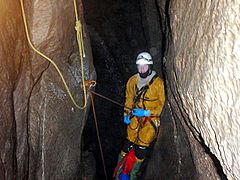Swinsto Cave facts for kids
Quick facts for kids Swinsto Cave |
|
|---|---|
| Swinsto Hole | |

A caver descending Spout Pitch in Swinsto Cave
|
|
| Location | Kingsdale, North Yorkshire |
| OS grid | SD 6938 7753 |
| Depth | 131 metres (430 ft) |
| Length | 914 metres (2,999 ft) |
| Elevation | 384 metres (1,260 ft) |
| Discovery | before 1890 |
| Geology | Carboniferous limestone |
| Entrances | 3 (including Simpson Pot and Turbary Pot) |
| Difficulty | Grade 4 |
| Hazards | water, verticality |
| Access | Free |
| Cave survey | On Cavemapper |
Swinsto Cave, also known as Swinsto Hole, is an exciting limestone cave located in West Kingsdale, North Yorkshire, England. It's a popular spot for cavers, who are people who explore caves. This cave is special because you can go down deep into it by using ropes, a technique called abseiling.
After exploring Swinsto Cave, cavers can exit through another part of the cave system called Valley Entrance of Kingsdale Master Cave. Swinsto Cave is part of a much larger cave system, about 27-kilometre (17 mi) long. This huge underground network helps drain water from both sides of the Kingsdale valley.
Contents
Exploring Swinsto Cave: What You'll See
The entrance to Swinsto Cave is in a shakehole, which is a bowl-shaped dip in the ground. You'll first enter a small passage where a stream flows. This passage soon gets bigger, allowing you to walk through it.
The Pitches and Passages
- First Pitch: You'll soon reach a 6 metres (20 ft) drop, called a pitch, where water enters from the side.
- The Long Crawl: Below this first pitch is a 234-metre (768 ft) long passage. It's called The Long Crawl because you'll need to crawl, and some parts can be wet!
- More Pitches: After the crawl, there's a short second pitch. Then, three more pitches quickly lead you down into a chamber filled with spray from a waterfall.
- Turbary Inlet: A little further, a 143-metre (469 ft) long passage called Turbary Inlet joins from the right. This passage leads to McShea Chamber in Turbary Pot, which is another way to enter the cave.
Deep Inside the Cave
The main path continues, with several small waterfalls (cascades) and two more small pitches. Eventually, you'll reach a larger area. Here, water from Simpson Pot enters from high up on the left.
The combined streams then drop down a short climb into Swinsto Final Chamber. This chamber is filled with large rocks. Above it, Swinsto Great Aven rises 45 metres (148 ft) high. This is a tall, narrow shaft that goes up from the cave floor.
Connecting to Kingsdale Master Cave
From Swinsto Final Chamber, you can reach Kingsdale Master Cave through two different passages:
- Philosopher's Crawl: On one side of the waterfall, you can climb down through rocks into a passage known as Philosopher's Crawl.
- East Entrance Passage: On the other side of the chamber, climbing down over more rocks leads you into East Entrance Passage.
How Swinsto Cave Was Formed
Swinsto Cave is a karst cave. This means it was formed in limestone rock by water dissolving the rock over millions of years. The limestone here was laid down about 335 million years ago, during a time called the Carboniferous Period.
Water's Journey Underground
The cave takes water from a stream called Swinsto Hole Syke. This water then flows into the West Kingsdale Master Cave System. It joins with water from other caves like Simpson Pot, Rowten Cave, Bull Pot, and Yordas Cave. All this water eventually comes out at a place called Keld Head, about a kilometer to the south.
Swinsto Cave is a great example of a "vadose" cave. This means it was formed by water flowing downwards, like a river, creating steps and drops. The upper parts of the cave follow flat layers of rock. But when the water hits cracks in the rock, it drops quickly down a series of shafts.
At about −65 metres (−213 ft) deep, the passage meets an older cave system that was once completely filled with water (a "phreatic" system). The stream has since carved a deeper channel within this older system. Both Swinsto Great Aven and Swinsto Final Chamber were formed along small cracks in the rock called faults.
A Look Back: The History of Swinsto Cave Exploration
People have known about Swinsto Cave for a long time. The first mention of it was in a book by Balderstone in 1890. He described how you could go about 30 metres (98 ft) into the cave before reaching "a deep wide hole, with high vaulted roof, fine cone-like stalactites, and waterfall thirty feet high."
Early Explorers
- 1908: A group from the Yorkshire Ramblers Club went down the first pitch. They explored for about 90 metres (300 ft) before turning back because the passage became too low and wet.
- 1930: Over 20 years later, a team from the Gritstone Club finally reached the very bottom of the cave. This was a huge achievement! They worked for a year, making many trips, and their success came from lowering the water levels in The Long Crawl.
Connecting the Caves
- 1948: Members of the British Speleological Association explored Simpson Pot and found a way through to Swinsto Cave.
- 1962: The Turbary Inlet was first explored by a group from the University of Leeds Speleological Association (ULSA).
- 2020: The connection between Turbary Inlet and Turbary Pot was finally made by Andy Jones, Darren McKenzie, and Dave Ramsay.
- 1965: The route to Kingsdale Master Cave was first found in November 1965. A ULSA team dug through a blockage in Final Chamber to open up what became known as Philosopher's Crawl.

